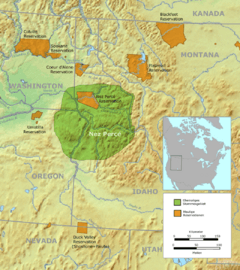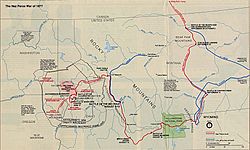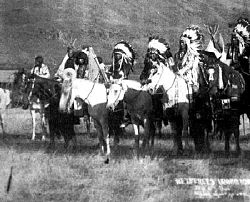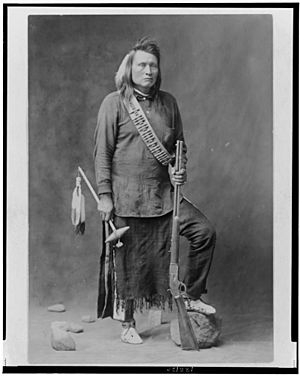Nez Perce War facts for kids
Quick facts for kids Nez Perce War |
|||||||
|---|---|---|---|---|---|---|---|
| Part of the American Indian Wars | |||||||
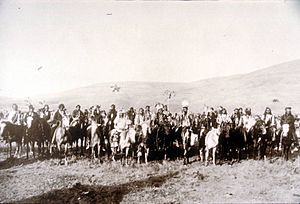 Chiefs Joseph, Looking Glass and White Bird in the spring of 1877. |
|||||||
|
|||||||
| Belligerents | |||||||
| Nez Percé Palouse |
|||||||
| Commanders and leaders | |||||||
| Chief Joseph Looking Glass† White Bird Ollokot† Toohoolhoolzote† Poker Joe† (Lean Elk) Red Echo (Hahtalekin) Bald head (Husishusis Kute) |
|||||||
| Strength | |||||||
| 1,500 soldiers, civilian volunteers, Indian scouts | 250 warriors, +500 non-combatant women and children—numbers are approximate | ||||||
| Casualties and losses | |||||||
| 125 killed, 146 wounded | 103–133 combatants and noncombatants killed, 71–91 combatants and noncombatants wounded (possibly more) 418 surrendered, 150–200 escaped to Canada |
||||||
The Nez Perce War was a conflict between several groups of the Nez Perce tribe and their allies, the Palouse tribe, against the United States Army. This war happened between June and October 1877.
The main reason for the war was that some Nez Perce groups, called "non-treaty Indians," refused to leave their traditional lands in the Pacific Northwest. The U.S. government wanted them to move to a smaller Indian reservation in Idaho. This demand went against an earlier agreement from 1855, called the Treaty of Walla Walla. This treaty had given the Nez Perce 7.5 million acres of their ancestral lands. It also allowed them to hunt and fish on lands given to the U.S. government.
After the first fights in June, the Nez Perce began a very difficult journey north. They hoped to get help from the Crow tribe. When the Crow tribe refused to help, the Nez Perce decided to try and reach Canada. They wanted to find safety with the Lakota tribe, led by Sitting Bull, who had already gone to Canada.
The U.S. Army chased the Nez Perce for about 1,170 miles (1,880 km). The Nez Perce fought many battles and smaller fights as they retreated. The war ended after a five-day battle near the Bears Paw Mountains in Montana. This spot was only 40 miles (64 km) from the Canada–US border.
Most of the surviving Nez Perce, led by Chief Joseph of the Wallowa band, surrendered to Generals Oliver Otis Howard and Nelson A. Miles. However, White Bird and some of his group managed to escape to Sitting Bull's camp in Canada. The 418 Nez Perce who surrendered, including women and children, were taken prisoner. They were sent by train to Fort Leavenworth, Kansas.
Even though Chief Joseph is the most famous Nez Perce leader, he was not the only one in charge. The "non-treaty" Nez Perce were led by several chiefs. These included Joseph's brother Ollokot, White Bird, Toohoolhoolzote, and Looking Glass. General Howard was the U.S. Army leader trying to force the Nez Perce onto the reservation. Chief Joseph gave his famous "I Will No Longer Fight Forever More" speech when he surrendered. An interpreter named Arthur Chapman translated it.
Contents
Why the War Started
In 1855, the U.S. government held a meeting called the Walla Walla Council. During this meeting, the Nez Perce were pressured to give up some of their traditional lands. They agreed to give up about 5.5 million acres of their 13 million-acre homeland. In return, they were allowed to keep a large part of their lands in Idaho, Washington, and Oregon. The treaty also said they could hunt and fish on their former lands, just like other citizens.
The new Nez Perce reservation was huge, covering about 7.5 million acres (30,000 km2). The treaty stated that no white settlers could enter the reservation without the Nez Perce's permission.
Gold Rush and Broken Promises
In 1860, gold was found near what is now Pierce, Idaho. About 5,000 gold-seekers rushed onto the reservation, which was against the treaty. They even built a city called Lewiston on Nez Perce land. More settlers, like ranchers and farmers, followed. The U.S. government did not stop these settlers from moving onto Native American lands.
The Nez Perce were very upset because the U.S. government did not keep its promises. Settlers were taking their land and plowing up their camas prairies. The Nez Perce relied on these prairies for food.
Smaller Reservation and Rising Tensions
In 1869, some Nez Perce were forced to sign away 90% of their reservation. This left them with only 750,000 acres (3,000 km2) in Idaho. This new treaty said that all Nez Perce had to move to this much smaller reservation. However, many Nez Perce did not agree with this new treaty. They refused to move and stayed on their traditional lands.
The Nez Perce who accepted the treaty were mostly Christian. Those who opposed it followed their traditional religion. Chief Joseph's group, who lived in the Wallowa valley in Oregon, was among those who refused to move. Arguments with white farmers and ranchers in the area sometimes led to violence.
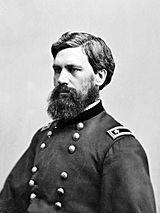
Tensions between the Nez Perce and white settlers grew in 1876 and 1877. General Oliver Otis Howard held a meeting in May 1877. He ordered the "non-treaty" groups to move to the reservation within 30 days. This was a very short deadline. Howard even put an old Nez Perce leader, Toohoolhoolzote, in jail for speaking against the move.
Other Nez Perce leaders, including Chief Joseph, felt that fighting the army would not work. They agreed to move and went to Fort Lapwai, Idaho. By June 14, 1877, about 600 Nez Perce from Joseph's and White Bird's groups had gathered at Camas Prairie.
Just before the deadline, some young Nez Perce warriors, angered by past wrongs, attacked white settlements. Chief Joseph and his brother Ollokot were not there during these attacks. When they returned, most of the Nez Perce had moved to a new camp to wait for General Howard's response. Joseph thought about asking for peace, but he knew it was too late after the attacks.
Meanwhile, General Howard sent 130 soldiers, including 13 friendly Nez Perce scouts, to punish the Nez Perce. Howard expected his soldiers to finish the job quickly. However, the Nez Perce defeated the soldiers at the Battle of White Bird Canyon. This battle marked the beginning of their long journey eastward to escape the U.S. Army.
The War Journey
After several battles and skirmishes in Idaho, Chief Joseph and White Bird were joined by Looking Glass's group. About 250 Nez Perce warriors, along with 500 women and children, and over 2,000 horses, began an amazing fighting retreat.
They traveled from Idaho over Lolo Pass into Montana Territory. They went southeast, briefly entered Yellowstone National Park, and then headed north into Montana. Their journey covered about 1,170 miles (1,880 km). They tried to find safety with the Crow Nation, but the Crow refused to help. So, the Nez Perce decided to try and reach Canada.
A small number of Nez Perce fighters, fewer than 200, managed to defeat or hold off much larger U.S. Army forces in several battles. The most famous battle was the two-day Battle of the Big Hole in southwestern Montana. This battle had many casualties on both sides, including many Nez Perce women and children. Before this battle, the Nez Perce hoped they could end the war on their own terms. After Big Hole, the fighting became much more intense.
The war ended when the Nez Perce stopped to rest near the Bears Paw Mountains in Montana. They were only 40 miles (64 km) from the Canadian border. They thought they had escaped General Howard and his soldiers. But they did not know that General Nelson A. Miles had been sent to find and stop them.
Miles led a combined force of soldiers and Indian Scouts. Many of these scouts were Lakota and Cheyenne who had fought against the Army just a year before. They launched a surprise attack on the Nez Perce camp on September 30. After three days, General Howard arrived, and the situation changed. Chief Joseph surrendered on October 5, 1877. He gave his famous speech, saying he would "fight no more forever."
In total, the Nez Perce fought against 2,000 American soldiers and their Native American allies. They had 18 fights, including four major battles. Many people praised the Nez Perce for their brave actions and skilled fighting. General William Tecumseh Sherman said it was "one of the most extraordinary Indian Wars of which there is any record." He noted that the Nez Perce fought with "almost scientific skill."
The Surrender and Its Aftermath
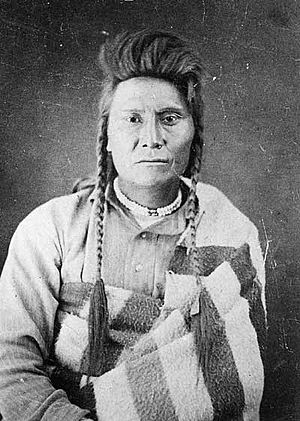
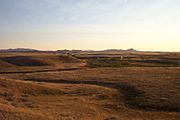
When Chief Joseph formally surrendered on October 5, 1877, many European Americans saw him as the main chief and the smart leader behind the Nez Perce's retreat. The American newspapers even called him "the Red Napoleon" because of his military skills. However, the Nez Perce groups involved in the war did not see him as a war chief. Joseph's younger brother, Ollokot, along with Poker Joe and Looking Glass, were among those who planned the fighting and led the warriors. Joseph's role was to protect the camp.
Chief Joseph became famous for his surrender speech:
I am tired of fighting. Our chiefs are killed. Looking Glass is dead. Toohoolhoolzoote is dead. The old men are all dead. It is the young men who say, "Yes" or "No." He who led the young men [Ollokot] is dead. It is cold, and we have no blankets. The little children are freezing to death. My people, some of them, have run away to the hills, and have no blankets, no food. No one knows where they are -- perhaps freezing to death. I want to have time to look for my children and see how many of them I can find. Maybe I shall find them among the dead. Hear me, my chiefs! I am tired. My heart is sick and sad. From where the sun now stands I will fight no more forever.
Arthur Chapman, an interpreter, translated Joseph's speech. Lieutenant C. E. S. Wood, an aide to General Howard, wrote it down. Wood was also a writer and poet. Some people think he might have added some poetic touches to Joseph's words.
Broken Promises and New Homes
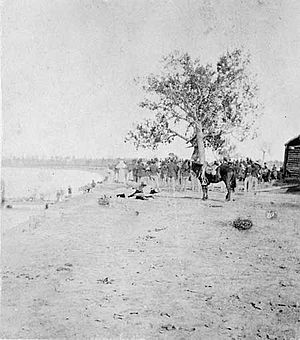
During the surrender talks, Generals Howard and Miles promised Joseph that the Nez Perce could return to their reservation in Idaho. But the head of the Army, General William Tecumseh Sherman, changed this plan. He ordered the Nez Perce to be sent to Kansas instead. Chief Joseph later said, "I believed General Miles, or I never would have surrendered."
Miles marched his captives 265 miles (426 km) to the Tongue River Cantonment in Montana. They stayed there for about a week. The healthy warriors were then sent to Fort Buford. On November 1, the women, children, and sick Nez Perce traveled to Fort Buford by boat.
From November 8 to 10, the Nez Perce left Fort Buford for Fort Abraham Lincoln in North Dakota. Many people in Bismarck, North Dakota, welcomed the Nez Perce prisoners. They even provided a large meal for them. On November 23, the Nez Perce prisoners and their belongings were loaded onto trains for the trip to Fort Leavenworth in Kansas.
At Fort Leavenworth, the Nez Perce were forced to live in a swampy area. This caused many of them to become sick. One writer described them as "400 miserable, helpless, emaciated specimens of humanity."
In January 1879, Chief Joseph traveled to Washington, D.C. He asked that his people be allowed to return to Idaho or at least be given land in what would become Oklahoma. He met with the President and Congress. His story was published in a magazine. While he was well-received, the U.S. government did not grant his wish because of strong opposition in Idaho. Instead, Joseph and the Nez Perce were sent to Oklahoma. They eventually settled on a small reservation near Tonkawa, Oklahoma. The conditions there were not much better than at Leavenworth.
Finally, in 1885, Joseph and 268 surviving Nez Perce were allowed to return to the Pacific Northwest. However, Joseph was not allowed to go back to the Nez Perce reservation. Instead, he settled at the Colville Indian Reservation in Washington. He passed away there in 1904.
The Nez Perce War in Media
Books
General Oliver Otis Howard, who led the U.S. troops, wrote a book in 1881. It was called Nez Perce Joseph: An Account of His Ancestors, His Lands, His Confederates, His Enemies, His Murders, His War, His Pursuit and Capture. This book described the Nez Perce campaign from his point of view.
The Nez Perce side of the story was told in Yellow Wolf: His Own Story, published in 1944. The author, Lucullus Virgil McWhorter, interviewed Yellow Wolf, a Nez Perce warrior. This book is very critical of the U.S. military's actions. McWhorter also wrote Hear Me, My Chiefs!, which used historical documents to support both sides of the story.
Television
In 1975, a historical TV drama called I Will Fight No More Forever was released. It starred Ned Romero as Joseph and James Whitmore as General Howard. This show was popular and helped bring attention to Native American issues. It tried to show a balanced view of the events, including the challenges Joseph faced as a leader and the Army's difficult task.
Song
Folk singer Fred Small's 1983 song "The Heart of the Appaloosa" tells the story of the Nez Perce War. It highlights how the Nez Perce skillfully used their Appaloosa horses in battle and during their escape. The song mentions Chief Joseph's Nez Perce name, "Thunder Rolling Down the Mountain," and includes parts of his "I will fight no more forever" speech.
The Texas country band Micky & the Motorcars released a song called "From Where the Sun Now Stands" in 2014. This song describes the Nez Perce's journey through Idaho and Montana.
Images for kids
See also
 In Spanish: Guerra Nez-Percé para niños
In Spanish: Guerra Nez-Percé para niños


